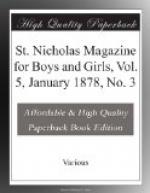Here is a suggestion for such of you as live by the sea, and who know something about drawing. Search for clam-shells on the beach, and select the whitest and most perfectly formed. Separate the two shells, cleanse them thoroughly, and make on the smooth pearly lining of each a little drawing in sepia. It will serve as a receiver to stand on a lady’s toilet and hold rings and trinkets, or it can be used as an ash-holder by a smoking gentleman, or to contain pens on a writing-table.
A SHOE-CHAIR MADE OF A BARREL.
Another shoe-chair as nice as that pictured on page 56 can be made out of a barrel by any girl who has a father or big brother to help her a little with the carpentering. The barrel is cut as in Fig. 1 below, so as to form a back and a low front. The back is stuffed a little, and covered with chintz nearly down to the floor. The front has a deep frill tacked on all around the chair. Four blocks are nailed inside the barrel to support a round of wood, stuffed and cushioned with the same chintz, to serve as a seat.
A straight shoe-bag, with eight pockets, is made in the same chintz, and tacked firmly all around the inside. A loop of the chintz serves to raise the seat. Four castors screwed to the bottom of the barrel will be an improvement, as the chair without them cannot easily be moved about. About five yards of chintz will be required for the covering; or you might use the merino of an old dress.
[Illustration: 1. SHOWS MANNER OF CUTTING BARREL. 2. BARREL SHOE-CHAIR COMPLETED. 3. INTERIOR OF BARREL SHOE-CHAIR. 4. DIAGRAM SHOWING MODE OF MAKING POCKETS FOR BARREL SHOE-CHAIR.]
A MUSLIN TIDY.
Three-quarters of a yard of clear French muslin will be needed for this. Lay a large dinner-plate down on the muslin, draw the circle made by its edge with a pencil, cut out, and lightly whip it round, pulling the thread a little to keep the circle perfect. Measure the circle, and cut a straight muslin ruffle, five inches wide and a little less than twice as long as the measure. Roll one edge finely, and overhand on a plain lace footing an inch and a half wide. Whip the other edge, and sew it round the circle, graduating the fullness equally.
[Illustration: A MUSLIN TIDY TRIMMED WITH LACE FOOTING.]
Baste a bit of lace footing three-quarters of an inch wide in the middle of the circle, giving it the form of a bow-knot with two ends. The lace must be bent and folded into the form, but not cut. Run the edges with embroidery cotton, and button-hole all round. Then, with sharp scissors, cut away the muslin underneath, leaving the bow-knot transparent on a thicker ground. Dry-flute the ruffle. This little affair is very dainty and odd, one of the prettiest things which we have seen lately.




